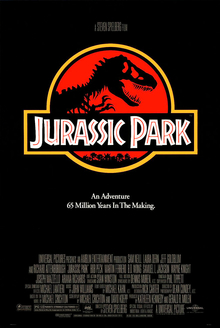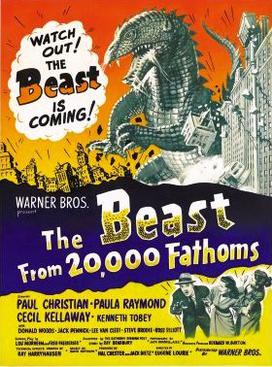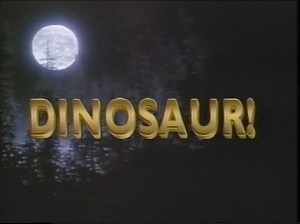
Willis Harold O'Brien, known as Obie O'Brien, was an American motion picture special effects and stop-motion animation pioneer, who according to ASIFA-Hollywood "was responsible for some of the best-known images in cinema history," and is best remembered for his work on The Lost World (1925), King Kong (1933), The Last Days of Pompeii (1935) and Mighty Joe Young (1949), for which he won the 1950 Academy Award for Best Visual Effects.

Jurassic Park is a 1993 American science fiction action film directed by Steven Spielberg, produced by Kathleen Kennedy and Gerald R. Molen, and starring Sam Neill, Laura Dern, Jeff Goldblum, and Richard Attenborough. It is the first installment in the Jurassic Park franchise, and the first film in the original Jurassic Park trilogy, and is based on Michael Crichton's 1990 novel of the same name, with a screenplay by Crichton and David Koepp. The film is set on the fictional island of Isla Nublar, off Central America's Pacific Coast near Costa Rica, where a wealthy businessman John Hammond (Attenborough), and a team of genetic scientists have created a wildlife park of de-extinct dinosaurs. When industrial sabotage leads to a catastrophic shutdown of the park's power facilities and security precautions, a small group of visitors, including Hammond's grandchildren, struggle to survive and escape the now perilous island.

The Beast from 20,000 Fathoms is a 1953 American science fiction action horror film directed by Eugène Lourié, with special effects by Ray Harryhausen. The film stars Paul Christian, Paula Raymond, Cecil Kellaway, and Kenneth Tobey. The screenplay is based on Ray Bradbury's 1951 short story "The Fog Horn", specifically the scene where a lighthouse is destroyed by the title character. The film is about the Rhedosaurus, a dinosaur that is released from its frozen hibernating state by an atomic bomb test in the Arctic Circle and begins to wreak a path of destruction as it travels southward, eventually arriving at its ancient spawning grounds, which includes New York City.

The Valley of Gwangi is a 1969 American fantasy Western film produced by Charles H. Schneer and Ray Harryhausen, directed by Jim O'Connolly, written by William Bast, and starring James Franciscus, Richard Carlson, and Gila Golan.

Legend is a 1985 American epic dark fantasy adventure film directed by Ridley Scott, and starring Tom Cruise, Mia Sara, Tim Curry, David Bennent, Alice Playten, Billy Barty, Cork Hubbert and Annabelle Lanyon. The film revolves around Jack, a pure being who must stop the Lord of Darkness who plots to cover the world with eternal night.

The Son of Kong is a 1933 American Pre-Code adventure monster film produced by RKO Pictures. Directed by Ernest Schoedsack and featuring special effects by Willis O'Brien and Buzz Gibson, the film stars Robert Armstrong, Helen Mack and Frank Reicher. The film is the sequel to King Kong, being released just nine months after and is the second entry of the King Kong franchise.

The Lost World is a 1925 American silent fantasy giant monster adventure film directed by Harry O. Hoyt and written by Marion Fairfax, adapted from Arthur Conan Doyle's 1912 novel of the same name.
James Danforth is an American stop-motion animator, known for model-animation, matte painting, and for his work on When Dinosaurs Ruled the Earth (1970), a theme-sequel to Ray Harryhausen's One Million Years B.C. (1967). He later went on to work with Ray Harryhausen on the film Clash of the Titans (1981) to mainly do the animation of the winged horse Pegasus.
David W. Allen was an American film and television stop motion model (puppet) animator.

Dinosaurus! is a 1960 science fiction film directed by Irvin Yeaworth and produced by Jack H. Harris.
Creation is an unfinished feature film, and a project of stop motion animator Willis O'Brien. It was about modern men encountering dinosaurs and other prehistoric animals on an island. The picture was scrapped by RKO studio head David O. Selznick on the grounds of expense, and Merian C. Cooper, the studio producer who recommended the film's cancellation, considered the storyline to be boring, due to lack of action. The completed footage ran 20 minutes in length, although approximately five minutes is all that survives today. The surviving footage shows a stop motion dinosaur watching a live action boy hunting a live action animal. Cooper later used some of the miniatures and dinosaur armatures and O'Brien's stop-motion animation techniques for King Kong.

Tyrannosaurus rex is unique among dinosaurs in its place in modern culture; paleontologist Robert Bakker has called it "the most popular dinosaur among people of all ages, all cultures, and all nationalities". Paleontologists Mark Norell and Lowell Dingus have likewise called it "the most famous dinosaur of all times." Paleoartist Gregory S. Paul has called it "the theropod. [...] This is the public's favorite dinosaur [...] Even the formations it is found in have fantastic names like Hell Creek and Lance." Other paleontologists agree with that and note that whenever a museum erects a new skeleton or bring in an animatronic model, visitor numbers go up. "Jurassic Park and King Kong would not have been the same without it." In the public mind, T. rex sets the standard of what a dinosaur should be. Science writer Riley Black similarly states, "In all of prehistory, there is no animal that commands our attention quite like Tyrannosaurus rex, the king of the tyrant lizards. Since the time this dinosaur was officially named in 1905, the enormous carnivore has stood as the ultimate dinosaur."

Carnosaur is a 1993 American science fiction horror film written and directed by Adam Simon. The film stars Diane Ladd, Raphael Sbarge, Jennifer Runyon, and Harrison Page. Loosely based on the 1984 John Brosnan novel of the same name, it follows characters Doc Smith and Ann Thrush in their efforts to thwart Dr. Jane Tiptree's plan to exterminate the human race with a lethal virus and replace them with her own genetically created dinosaurs.

The Rhedosaurus is a fictional dinosaur that debuted in the 1953 monster film The Beast from 20,000 Fathoms, directed and co-written by Eugène Lourié. The Rhedosaurus is depicted as a giant, destructive, prehistoric reptile that is immune to most modern artillery in its major on-screen appearance, and would later appear in the 1977 science fiction film Planet of Dinosaurs.

The Ghost of Slumber Mountain is a 1918 film written and directed by special effects pioneer Willis O'Brien, produced by Herbert M. Dawley, and starring both men. It is the first film to show live actors and stop-motion creatures together on the screen and is often cited as a trial run for The Lost World. An advertising tagline for the film read "These giant monsters of the past are seen to breathe, to live again, to move and battle as they did at dawn of life." [sic] The film attracted the interest of Watterson R. Rothacker, founder of the Industrial Motion Picture Company, who was so impressed by the film's special effects, he joined forces with O'Brien to create the dinosaurs of The Lost World (1925), a classic that advanced the development of special effects techniques.

Stegosaurus is one of the most recognizable types among cultural depictions of dinosaurs. It has been depicted on film, in cartoons, comics, as children's toys, as sculpture, and even was declared the state dinosaur of Colorado in 1982. Stegosaurus is a subject for inclusion in dinosaur toy and scale model lines, such as the Carnegie Collection.

The Land Unknown is a 1957 science fiction CinemaScope adventure film about a naval expedition trapped in an Antarctic jungle. The story was allegedly inspired by the discovery of unusually warm water in Antarctica in 1947. It stars Jock Mahoney and Shirley Patterson and was directed by Virgil W. Vogel. The film's low-budget special effects include men in dinosaur suits, puppets and monitor lizards standing in for dinosaurs.

The Last Dinosaur is a 1977 Japanese/American tokusatsu co-production, co-directed by Alexander Grasshoff and Tsununobu Kotani, and co-produced by Japan's Tsuburaya Productions and Rankin/Bass Productions. The picture was filmed at Tsuburaya Studios in Tokyo and on location in the Japanese Alps. The film was intended for a U.S. theatrical release, but failed to find a distributor and ended up as a television film, airing on ABC on February 11, 1977 in an edited 92-minute run time. The film was eventually picked up for overseas markets by Cinema International Corporation, where it was released in the unedited 106-minute version as a double feature in the U.K. with the edited version of Sorcerer. Toho also picked up distribution rights to The Last Dinosaur in Japan for a theatrical release utilizing the unedited 106-minute version in English with Japanese subtitles, and later the film debuted on Japanese television dubbed in Japanese.

Dinosaur! is a 1985 American television documentary film about dinosaurs. It was first broadcast in the United States on November 5, 1985, on CBS. Directed by Robert Guenette and written by Steven Paul Mark, Dinosaur! was hosted by the American actor Christopher Reeve, who some years before had played the leading role of Superman.
Godzilla: King of the Monsters in 3D was an unproduced American film project that was developed in 1983 by Steve Miner, with Miner attached to direct the film. Miner shopped the project around Hollywood and generated some interest, but was unable to secure funding and let the rights revert to Toho. The project was the first attempt to produce a Godzilla film at an American film studio.
















